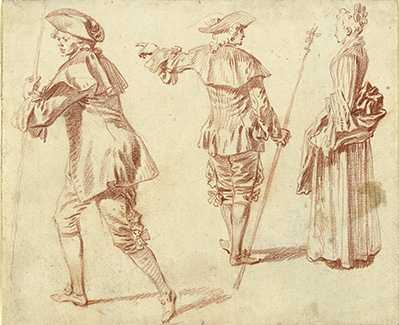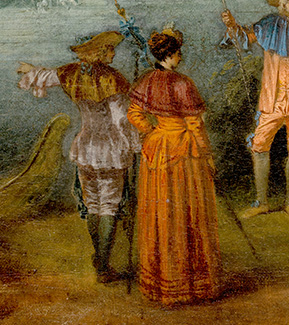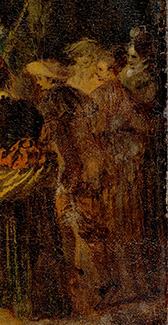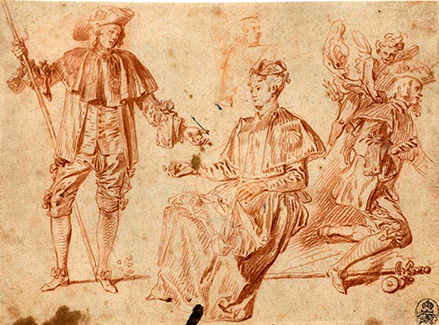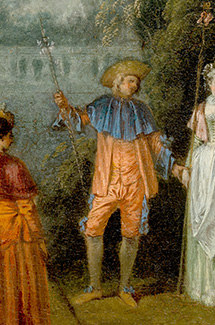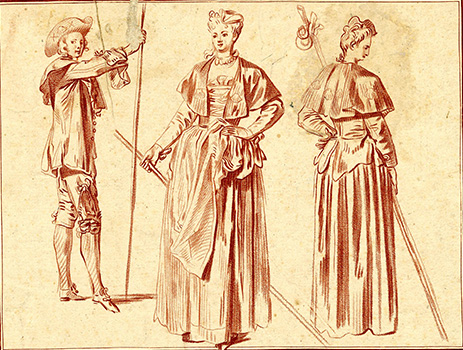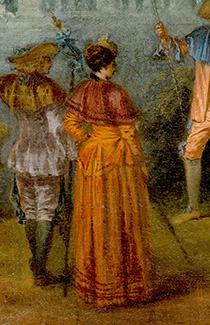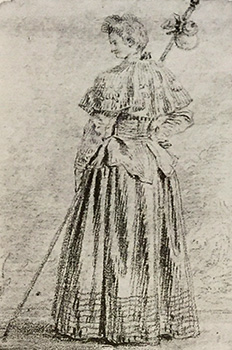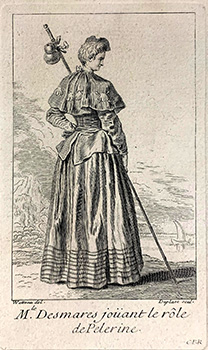
- Home Page
- Accepted
Paintings & Copies - Doubtful
Attributions - Doubtful Textual References
- Alternative
Titles - Collectors &
Museums - Bibliography
- Search Abecedario
- Watteau &
His Circle
L’Île de Cythère
Entered February 2024; revised August 2024
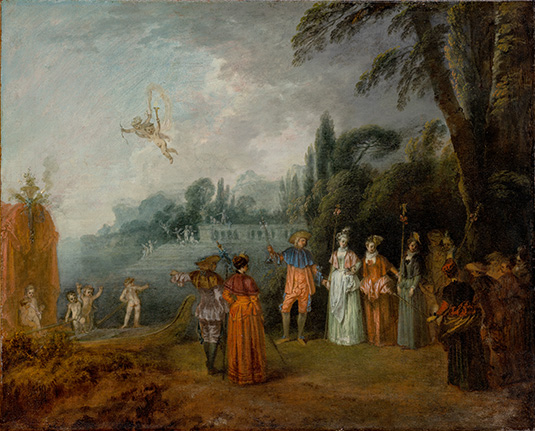
Frankfurt am Main, Städel Museum
Oil on canvas
45.5 x 56 cm
ALTERNATIVE TITLES
A Bridal Procession
L’Ile de Cythere
L’Ille de Cithere
L’isle de Cithère
Ladies and Gentlemen Embarking for the Isle of Cythera
RELATED PRINTS
L’Île de Cythère was engraved twice, and the circumstances behind this are not clear.
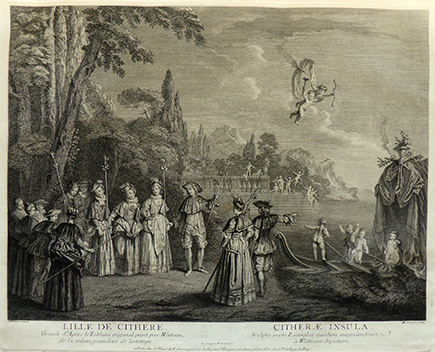
Nicolas de Larmessin after Watteau, L’Ile de Cythère, engraving, 1730.
L’Ile de Cythere was engraved in reverse by Nicolas de Larmessin. The print was announced for sale in the August 1730 issue of Mercure de France, p. 1831. The caption on that print indicates that the painting was "de la meme grandeur de lestempe [sic]." However, while the print measures 33.2 x 44.1 cm, the two paintings associated with this composition are larger: the Frankfurt painting is 43.1 x 53.3 cm, and the ex-Heughel picture (our copy 1) is 46.5 x 56 cm.
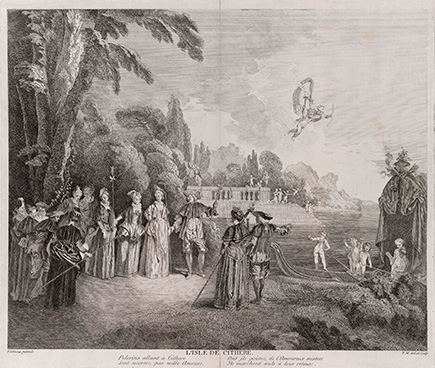
Philippe Mercier, after Watteau, L’Ile de Cythère, engraving, c. 1720s.
L'Île de Cythère was also engraved in reverse by Philippe Mercier, supposedly in London in the 1720s. Mariette in his “Notes manuscrites” specified that it was "gravée à l'eau forte, à Londres." But this may have been Mariette’s surmise, based on his knowledge that Mercier established his career in the British capital.
PROVENANCE
Wimbledon, Surrey, and London, collection of Thomas Walker (d. 1748; tax commissioner). The painting was probably in England c. 1725, the presumed date of Mercier's engraving. By descent to his nephew, Stephen Skinner; by descent to his eldest daughter Emma, wife of William Harvey, Rolls Park, Essex; by descent to their son, William Harvey (d. 1779), Rolls Park; by descent to his brother, Admiral Sir Eliab Harvey (d. 1830), Rolls Park; by descent to his daughter, Maria (Mrs. William Tower), Upp Hall, Braughing-Ware, by 1858; by descent to their daughter, Louisa (Mrs. Edward Goulburn), Betchworth House, Surrey; by descent to their son Major Henry Goulburn (d. 1928), Betchworth House; by descent to their son Cuthbert Edward Goulburn (d. 1944), Betchworth House; by descent to their son Major General Edward Henry Goulburn (1903-1980), Betchworth House.
London, sale, Christie's, collection of Major General Edward Henry Goulburn and others, December 18, 1980, lot 97: “J. A. Watteau, Ladies and gentlemen embarking for the Isle of Cythera / 17 x 21in. (43. X 53.3cm) / EXHIBITED: British Institution, 1858, no. 86 (as Watteau).“ Withdrawn before the sale.
London, sale, Christie's, collection of Major General Edward Henry Goulburn and others, December 11, 1981, lot 6: “attributed to Jean-Antoine Watteau / Ladies and gentlemen embarking for the Isle of Cythera / 17 × 21in. (43.1 × 53.3cm.) / PROVENANCE: Thought to have been in the collection of Thomas Walker of Wimbledon Heath (d. 1748) . . . and thence Stephen Skynner, by inheritance / William Harvey of Rolls Park, Essex, who married Skynner's eldest daughter, Emma Sir Eliab Harvey (d. 1830), their son / The Rev. W. Tower of Upp Hall, Broughing, Ware who, in 1829, married Harvey's elder daughter, Maria (by whom lent to the British Institution in 1858) Mrs. Edward Goulburn, their daughter /Major Henry Goulburn (d. 1928) and by descent / EXHIBITED: British Institution, 1858, no. 86 ENGRAVED: / (?) by Philippe Mercier in reverse . . .
The attribution of the present lot to Watteau depends on the possibility that the artist painted two versions of this composition (as has been suggested by A. Ferré Watteau, 1972, vol. III, p. 795, no. A.3), that is known by two engravings by Nicholas Larmessin IV and Philippe Mercier (see E. Dacier and A. Vuaflart, Jean de Jullienne et les graveurs de Watteau au XVIIIe Siècle, 1922, III, no. 155 and 155A). The rubric on Larmessin's engraving states that it was the same size as the prototype which was then in the Jullienne collection. That engraving measures 33.2 x 44.1cm., and no painting by Watteau of this composition with such measurements is known. The ex-Jullienne picture is thus lost (but see H. Adhémar. Watteau, Sa Vie, Son Oeuvre, 1950, p. 205, no. 33, where a larger picture is given this provenance). According to Mariette, Mercier's print was made in London but also after the Jullienne picture. If the print was indeed made in London it might seem improbable but not impossible for the Jullienne picture to have been the prototype, for it remained (presumably) in Paris. If Mariette was wrong about the prototype, it may well be significant that the present lot has the same measurements as the print
The detection of Prussian blue in the sky of the present lot may or may not be significant: the pigment was first made in 1704, but was not used by artists until 'circa' 1730—a time margin that might or might not allow its use by Watteau.” Sold for £132,000 to Maurice Segoura Gallery.New York and Paris, with Maurice Segoura Gallery. Sold in 1982 to the Städel Museum.
EXHIBITIONS
London, British Institution (1858), cat. 86 (as Watteau, A Bridal Procession, lent by Mrs. W. Tower).
New York, Segoura Gallery, From Watteau to David (1982), cat. 1 (as Watteau, L’Ile de Cythère).
Frankfurt, Stadische Galerie [Städel Museum], Einschiffung nach Cythera (1982).
SELECT BIBLIOGRAPHY
Mariette, “Notes manuscrites,” 9: fol. 193.
Hédouin, “Watteau” (1845), cat. 93.
Hédouin, Mosaïque (1856), cat. 94.
Goncourt, L’Art au XVIIIème siècle (1860), 57.
Goncourt, Catalogue raisonné (1875), cat. 140.
Staley, Watteau (1902), 26, 33, 150.
Fourcaud, “Scènes et figures théatrales” (1904), 205-213.
Zimmermann, Watteau (1912), pl. 29, 176.
Dacier, Vuaflart, and Hérold, Jean de Jullienne et les graveurs (1921-29), 1: 70, 101, 174 ; 2: 33, 62, 84, 97, 130, 142 ; 161; 3 : cat. 155.
Hildebrandt, Watteau (1922), 104.
Réau, “Watteau” (1928), cat. 153.
Gillet, La Peinture au Musée du Louvre (1929), 38.
Parker, Drawings of Watteau (1931), 32, 41.
Dacier, “L’Ile de Cythère” (1937), 247-51.
Mathey, “Remarques sur la chronologie” (1939), 153.
Michel, Aulanier, de Vallée, Watteau, L’Embarquement (1939), 13.
Locquin, “Contribution” (1947-48), 49-52.
Adhémar, Watteau (1950), cat. 33.
Tolnay, “Le Embarquement pour Cythère” (1955), 92-94.
Parker and Mathey, Watteau, son oeuvre dessiné (1957), under nos. 22, 23,168,171, 910.
Mathey, Watteau, peintures réapparues (1959), 38-39, 59, 67, 77.
Levey, “Watteau’s Embarkation for Cythera" (1961), 182.
Nemilova, Watteau and His Works (1964), 75, 87.
Levey, Rococo to Revolution (1966), 62-64.
Macchia and Montagni, L’opera completa di Watteau (1968), cat. 14.
York, City Art Gallery, Philip Mercier (1969), under cat. 6.
Brookner, Watteau (1969), pl. 9.
Mirimonde, “Sujets de musique chez Jacob Jordaens” (1969), 241.
Ferré, Watteau (1972), cat. A3.
Boerlin-Brodbeck, Watteau und das Theater (1973), 91, 123, 138-41, 151, 180-81, 186-86, 188-89, 196, 206, 228, 304, 340.
Mosby, “Claude Gillot’s Embarkation” (1974), 49-50.
Ferraton, “L’Embarqement pour Cythère” (1975), 84.
Ingamells and Raines, “Catalogue of Mercier” (1976-78), cat. 292.
Banks, Watteau and the North (1977), 227.
Ostrowski, “Pellegrinaggio a Ciera“ (1977), 12.
Eidelberg, Watteau’s Drawings (1977), iii, 96.
Mirimonde, “L’Iconographie musicale sous les rois Bourbons” (1977), 109-10
Paris-Geneva, Des Monts et des eaux (1980), cat. 44.
Roland Michel, Watteau (1981), cat. 124.
Tomlinson, La Fête galante(1981), 113-14, 131-32.
Frankfurt, Städelsche Kunstinstitut, Einschiffung nach Cythera (1982).
New York, Segoura Gallery, From Watteau to David (1982), cat. 1.
Duret-Robert, “Un Bernin pour mille Francs” (1982), 117-22.
Rosenberg, “Watteau à Francfort” (1983), 5-10.
Börsch-Supan, Antoine Watteaus Embarquement (1983), 16-21.
Posner, Watteau (1984), 53-54, 187-88.
Roland Michel, Watteau (1984), 45, 69, 87, 88, 213, 214, 215, 217, 266, 274-76.
Washington, Paris, Berlin, Watteau 1684-1721 (1984), under cat. D 22; cat. P 9.
Duret-Robert, “Qui décide de l’authenticité des tableaux?” (1986), 28-29.
Rosenberg and Prat, Watteau, Catalogue raisonné des dessins (1996), 47, 50, 51, 93, 138, 139, 414.
Hansert, Geschichte des Städelschen Museums (1994), 169-71.
Börsch-Supan, Watteau (2000), 64, 68.
Cowart, “Watteau’s Pilgrimage” (2001), 470.
Temperini, Watteau (2002), cat. 4.
Michel, Le «célèbre Watteau» (2008), 211.
New York, Metropolitan Museum, Watteau, Music, and Theater (2009), cat. 1.
Vogtherr, Französische Gemälde (2011), 171.
Glorieux, Watteau (2011), 103, 105, 108.
Eidelberg, "Histoire véridique" (2024), 544-45.
RELATED DRAWINGS
The young Watteau executed a surprisingly large number of studies of male and female pilgrims, much as he normally drew his many other studies of models. But these are exceptional in that the models are already in costumes appropriate to pilgrims—i.e., with short capes, staffs, and shell badges. Another unusual aspect of these sheets is that they contain three figures each—a strange regularity for Watteau, who usually was far freer in his approach. Also, some of the drawings have putti flying around the pilgrims, an exceptional situation for Watteau’s drawings drawn after live models.
One of the drawings directly related to the painting is now in Frankfurt (Rosenberg and Prat 138). The sheet includes two studies of a male pilgrim and another of a woman, similarly in pilgrim attire. The central figure, an actor seen from behind and with his arm extended, served for the actor at the center of Watteau’s painting. The striding man at the left of the Berlin sheet may have been used for a pilgrim at the right of the painting, but the correspondence is not as exact.
Another pertinent drawing in this series of Watteau studies of pilgrims is a sheet in Dresden (Rosenberg and Prat 139). The actor at the left of the sheet provided the guidelines for the man at the center of L’Île de Cythère.
Still another of Watteau’s sheets of three pilgrims showed a man and two women, but that sheet has not survived. However, its appearance is recorded in an engraving by Louis Marin Bonnet (1736-1793). The study of the standing woman at the right in the lost Watteau drawing and in the Bonnet engraving, seen in profile from behind, matches the figure in the foreground of the Frankfurt painting. The correspondences between the drawn and painted images are exact.
Watteau’s reliance on sheets with three related figures is an unusual aspect of this series. Just one additional sheet with a trio of pilgrims has come down to us, and it is in the Nationalmuseum, Stockholm (Rosenberg and Prat cat. 93). It is reasonable to assume, however, that there were yet others, and that Watteau would have employed them when he prepared L’Île de Cythère.
REMARKS
Watteau’s L’Île de Cythère is one of the artist’s important early works: it reflects his training with Claude Gillot and, at the same time, forecasts his mature career. It anticipates the Pèlerinage à l’île de Cythère in the Louvre, the picture with which he was accepted into the Académie royale in 1716. Not only does the Frankfurt painting bridge these two periods of his career but it is also well documented in his drawings so that we can follow something of his creative process.
Although there is still some disagreement or hesitation about the picture’s subject matter, most scholars accept the idea, advanced by Louis de Fourcaud at the turn of the twentieth century, that this painting depicts the finale of act 2 in Florent Carton Dancourt’s play, Les Trois cousines. There, three female cousins are exhorted to travel to the Island of Cythera, the cult site for the worship of Venus. They are promised that if they worship at the goddess’ shrine, they will be rewarded with a lover or a husband.
In Watteau’s composition, all the actors are compressed across the foreground ledge of space which represents, in effect, the theatrical stage. The three cousins, protectively gathered together at the right, are exhorted forward by the other pilgrims—mostly but not entirely men. The small barque that will transport them to Cythera waits at the left, staffed by putti. While the boat could have been an actual stage prop, the crew of putti reflects a painter’s poetic license. So too the landscape with its watery expanse should be understood as a painted backdrop, much as those found in actual Parisian theaters.
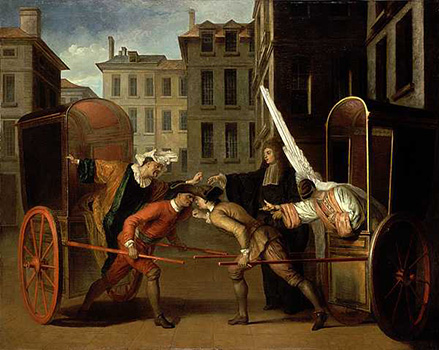
Claude Gillot, Les Deux carrosses, oil on canvas, 127 x 160 cm. Paris, Musée du Louvre.
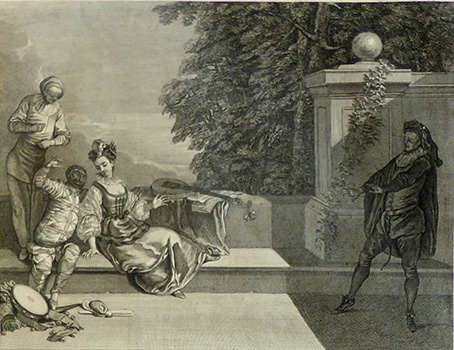
Charles Nicolas Cochin after Watteau, Belle n’ecoutez rien, engraving, before 1729.
One can see the ways in which L’Île de Cythère followed the theatrical conventions used by Gillot, as in his Deux Carrosses. Not least is how he insisted on the presence of a stage. This was also a key element in Watteau’s earliest theatrical subjects, such as his Belle n’ecoutez rien. But that distinction is somewhat softened in L’Île de Cythère, and then disappeared by the time that he painted the Louvre’s Pèlerinage à l'Île de Cythère. So too, the emotional tenor of the images changed. In Gillot’s pictures and in Watteau’s early scenes, there often is sarcasm, vibrant activity, confrontation, even hurly-burly. For his part, Watteau was drawn to more temperate theatrical moments, as in Belle n’ecoutez rien. And in L’Île de Cythère the mood is idyllic, despite the multitude of actors. The characters, mostly paired into couples, are ready for a quiet stroll into the verdant landscape. Love is in the air. Watteau inched still farther forward to the Louvre and Berlin paintings, where the decorum of pastoral poetry has displaced the chatter of French musical comedy.
The theme of pilgrims to Cythera can also be found in Watteau’s Figures françoises et comiques, a series of etchings that he executed around the time of the Frankfurt painting. Several of the preparatory drawings related to these etchings are extant, all essentially the same size and with slivers of landscape background. Not surprisingly, they have been interpreted in various ways—as studies from the model, as studies for this cycle of etchings, and as drawings used in preparation for L’Île de Cythère.
The study of a female pilgrim seen from behind (Rosenberg and Prat 50) is a good example of the problems we face. It shows an actress seen from behind, holding a pilgrim’s staff and wearing a cape with a shell badge—the emblems of a pilgrim. Attached at the top is a pilgrim’s bundle that is cut off, an indication that the sheet has been cut down slightly. At the bottom there are wisps of a distant landscape, and even wispier hints of clouds in the sky. This drawing was copied in reverse for the Figures françoises et comiques. Originally Watteau drew this woman from a model, one of three studies of pilgrims that he drew side by side. But, as already pointed out above, that sheet is lost. However it was recorded later in the eighteenth century by Louis Marin Bonnet. Watteau’s original study from the live model (and Bonnet’s engraving) included no indications of a landscape or sky. He used this study from the model for his painting, but when preparing to etch the Figures françoises et comiques he redrew that study and added the landscape background. If perhaps confusing at first, a patient examination of the various drawings and engravings reveals logical work sequences for both L’Île de Cythère and the Figures françoises et comiques, both of which were probably underway at the same time.
The dating of L’Île de Cythère is a matter of debate. Much of the argument has centered on when Dancourt’s Trois cousines was presented, but that occurred twice. The play opened in 1700 and was reprised in 1709, leaving a latitude of choices for dating Watteau’s painting. Without further explanation, Gillet chose c. 1704-05, Ostrowski favored 1705, and Temperini preferred 1706. The greater majority of scholars have chosen c. 1709-10. This includes Dacier and Vuaflart, Mathey, Adhémar, Brookner, Segoura and Janet, and Posner. A few have shaded the date slightly later. Vogtherr favored c. 1709-11, Glorieux preferred 1711, Roland Michel wrote in favor of 1712, the 1975 Brussels exhibition selected c. 1712-13, Dohme opted for 1713, and despite another opinion expressed elsewhere Roland Michel has also favored 1713-14. Also in favor of this late period, Rosenberg and Prat dated two related drawings (their cats. 138 and 139) to 1711-12; Grasselli would date these drawings, and thus the painting, still later: c. 1713. A century ago and for unexplained reasons, Zimmerman proposed 1714.
The history of the Frankfurt painting is a curious tale, largely of failed recognition. It left Paris early on, possibly in Watteau’s lifetime or shortly thereafter. Given that it was engraved by Philippe Mercier, either in Paris or London, he may have been the agent who brought the picture across the Channel. In this early portion of his career Mercier acted as a dealer, thus adding an additional layer to the painting’s narrative. It is thought, though not documented, that the painting entered the collection of the rich tax collector Thomas Walker (d. 1748). From then until the late twentieth century, the picture remained in the hands of his descendants and was almost never seen in public. Exceptionally, it was exhibited in 1858 at the British Institution in London, but few seem to have noticed. Part of the problem was that there was a well-known second version of the composition (our copy 1), and most believed that this was the original. In the late 1920s, an editor for The Art Journal, his interest in the Goulburn version piqued by its evident quality, sent an inquiry to the Louvre but they replied that it was by Pierre Antoine Quilllard—this the result of their having been “burnt” by having just bought two so-called Watteau pictures that were now reattributed to Quillard.
The rediscovery of the Goulburn picture began only after World War II, and proceded slowly. Ingamells and Raines alluded to the picture but did not disclose its location. On the other hand, two of Marcel Röthlisberger’s publications presented several important French seventeenth-century pictures owned by the Goulburn family, and this led David Carritt, a leading London dealer, to visit that collection. In turn, he brought me to see the Watteau and I immediately recognized its authenticity and primacy. Throughout the picture one sees the hand of an artist actively searching for form, changing and strengthening contours, lightening the color around silhouettes, defining and redefining features as he went. His impetuousness was revealed in the way he created the steps on the distant terrace, scratching directly into the wet paint—much as he delineated tree branches in the Metropolitan Museum’s Mezzetin, carving into the still-moist pigment. The turbulent application of pigment for the sky was another proof of Watteau’s authorship. Because he worked alla prima, many pentimenti were visible. The legs of one of the putti flying overhead were adjusted downward during the course of painting. Ghosts of other putti were visible under the clouds. The contour of the boat’s canopy was originally painted farther to the right. The distant hills were once higher, just as the clump of trees at the right had evidently been modified. Certainly this was not a dull, mechanical copy. However, due to privacy issues, in my publications on Watteau I was only able to allude to the Goulburn painting in slightly roundabout terms.
It was not until Major General Goulburn’s death in 1980 that the painting actually came into public view. It was scheduled to appear in a December 1980 auction, but only with a cautious attribution: it was ascribed to the artist’s era but was not deemed necessarily to be by the painter himself. Then, because so much interest in it was shown, Christie’s withdrew it at the last minute and sent it to a conservation lab. There the presence of Prussian blue pigment was found in the sky. As this substance was discovered in Berlin only in 1704, it was thought that there was insufficient time between its discovery and its accessibility in Paris by 1709-10, when the picture was thought to have been painted. However, none of that argument is pertinent since the painting may have been executed a few years later, and as has subsequently been realized, Prussian blue was employed by Watteau for many of his other early paintings such as La Mariée de village. Moreover, the pigment was employed by other Parisian artists around 1710. Yet this perspective was not in place in the 1980s. When the Goulburn painting came up at auction a second time, in late 1981, these precautionary warnings were still issued by Christie’s.
At auction, the painting was bought by Maurice Segoura and Christophe Janet, who showed it in New York in 1982. That same year it was sold to the Städel Museum in Frankfurt. The museum then quickly staged a monographic exhibition. It also was included in the 1984 Watteau tricentenary exhibition in Washington, Paris, and Berlin. Remarkably, despite the dissention normally surrounding all Watteau attributions, the Frankfurt painting has received unanimous acceptance, while the Heughel version, formerly in the place of honor, is now dismissed to the background.
One of the perplexing issues surrounding L’Île de Cythère is the existence of not only the two painted versions but also the pair of engravings by Larmessin and Mercier. The normal explanation would involve the presumption that as in so many other instances, Watteau painted his original picture and that an anonymous artist, working directly from the autograph version, copied it. Likewise, it would normally be presumed that the Larmessin engraving was commissioned by Jean de Jullienne for his Oeuvre gravé, while Mercier’s engraving was an independent undertaking. Adding to the complexity, Mariette wrote that Mercier executed his print in London though no indication of this appears on the engraving itself. Aware that Mercier had taken up residence in London, Mariette may only have intended to indicate Mercier’s move to England.
Previously, in 1982, I believed that minor differences in details allowed one to conclude that the Mercier engraving reproduced the Frankfurt version, and that the Larmessin engraving followed the ex-Heughel copy. However, further analysis suggests that conclusion was not justified.
The implications for Mercier are important: his close bond with the Frankfurt picture suggests that he possessed the actual work and that he was the one who transported it to England and sold it to Thomas Walker. Similarly, the implications for Jullienne and Larmessin are significant. Certainly Jullienne called upon Larmessin to execute the print, just as he hired him to engrave other pictures for the Oeuvre gravé, and, after all, he owned the painting.
Click here for copies of L’Île de Cythère
